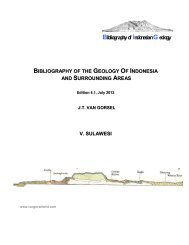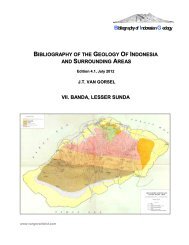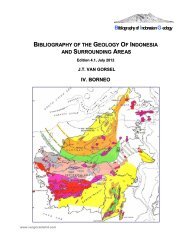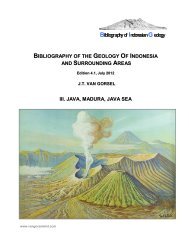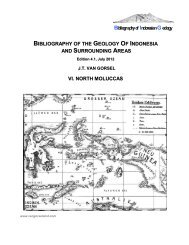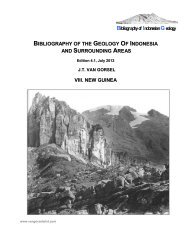Sumatra, Sunda Shelf, Natuna - Bibliography of Indonesia Geology
Sumatra, Sunda Shelf, Natuna - Bibliography of Indonesia Geology
Sumatra, Sunda Shelf, Natuna - Bibliography of Indonesia Geology
You also want an ePaper? Increase the reach of your titles
YUMPU automatically turns print PDFs into web optimized ePapers that Google loves.
('Revision <strong>of</strong> Pre-Tertiary foraminifera from SE <strong>Sumatra</strong>'. Cretaceous foraminifera from SE <strong>Sumatra</strong> described<br />
by Silvestri (1925) as Ch<strong>of</strong>fatella should be assigned to Pseudocyclammina Yabe and Hanzawa and Lacazina<br />
lamellifera is a L<strong>of</strong>tusia)<br />
Simanjuntak, T.O., Surono, S. Gafoer & T.C. Amin (1991)- Geological map <strong>of</strong> the Muara Bungo Quadrangle,<br />
Sumatera, 1: 250,000. Geol. Res. Dev. Centre, Bandung.<br />
(Jurassic K-Ar dates <strong>of</strong> 180 and 159 Ma from Tigapuluh and Duabelas Mts granites <strong>of</strong> South <strong>Sumatra</strong>, but may<br />
be reset <strong>of</strong> older granites; Pulunggono & Cameron 1984)<br />
Simoes, M., J. Avouac, R. Cattin & P. Henry (2004)- The <strong>Sumatra</strong> subduction zone: a case for a locked fault<br />
zone extending into the mantle. J. Geophys. Res. 109, B10, B10402, 16p.<br />
(Subduction interface locked between large interplate earthquakes (locked fault zone, LFZ), postulated to not<br />
extend into mantle because serpentinization <strong>of</strong> mantle wedge favors aseismic sliding. Uplift rates from coral<br />
growth and GPS indicate LFZ extends ~132 km from trench, to 35-57 km depth. LFZ extends below forearc<br />
Moho, estimated at ~30 km depth, 110 km from trench, probably into mantle)<br />
Singh, S.C., H. Carton, P. Tapponier, N.D. Hananto, A.P.S. Chauhan et al. (2008)-. Seismic evidence for broken<br />
oceanic crust in the 2004 <strong>Sumatra</strong> earthquake epicentral region. Nature Geosc. 1, p. 777-781.<br />
(<strong>Sumatra</strong> 2004 earthquake caused by sudden slip along plate interface between subducting Indo-Australian<br />
plate and overriding <strong>Sunda</strong> plate. Deep seismic section <strong>of</strong> focal region reveals subducting crust and oceanic<br />
Moho are broken and displaced by landward-dipping thrust ramps, suggesting megathrust now lies in oceanic<br />
mantle. Active thrust faults at front <strong>of</strong> accretionary wedgeconsistent with thrust aftershocks on steeply dipping<br />
planes. Brittle failure <strong>of</strong> mantle rocks accounts for initiation <strong>of</strong> exceptionally large earthquake)<br />
Singh, S.C., N.D. Hananto & A.P.S. Chauhan (2011)- Enhanced reflectivity <strong>of</strong> backthrusts in the recent great<br />
<strong>Sumatra</strong>n earthquake rupture zones, Geophys. Res. Lett. 38, L04302, p. 1-5.<br />
Singh, S.C., N.D. Hananto, A.P.S. Chauhan, H. Permana, M. Denolle, A. Hendriyana & D. Natawidjaja (2010)-<br />
Evidence <strong>of</strong> active backthrusting at the NE margin <strong>of</strong> Mentawai Islands, SW <strong>Sumatra</strong>. Geoph. J. Int. 180, 2, p.<br />
703-714.<br />
(Onshore Great <strong>Sumatra</strong> Fault takes up significant part <strong>of</strong> strike-slip motion <strong>of</strong> oblique subduction <strong>of</strong> Indo-<br />
Australian plate beneath <strong>Sunda</strong> plate, but <strong>of</strong>fshoreMentawai Fault characterized by active SW dipping<br />
backthrusts)<br />
Singh, S.C., N. Hananto, M. Mukti, H. Permana, Y. Djajadihardja & H. Harjono (2011)- Seismic images <strong>of</strong> the<br />
megathrust rupture during the 25th October 2010 Pagai earthquake, SW <strong>Sumatra</strong>: Frontal rupture and large<br />
tsunami, Geophys. Res. Lett., 38, L16313, p. 1-6.<br />
Singh, S.C., N.D. Hananto, M. Mukti, D.P. Robinson, S. Das, A. Chauhan, H. Carton, B. Gratacos, S. Midnet,<br />
Y. Djajadihardja & H. Harjono (2011)- Aseismic zone and earthquake segmentation associated with a deep<br />
subducted seamount in <strong>Sumatra</strong>. Nature Geoscience 4, p. 308-311.<br />
(Imaging <strong>of</strong> subducted seamount 3-4 km high and 40 km wide at 30–40 km below <strong>Sumatra</strong> forearc mantle.<br />
Seamount remained intact despite >160 km <strong>of</strong> subduction, and no seismic activity above or below seamount.<br />
Coupling between seamount and overriding plate appears weak and aseismic. Subduction <strong>of</strong> such a<br />
topographic feature could lead to segmentation <strong>of</strong> subduction zone)<br />
Siregar, B.S.A., Y.A. Nagarani, S.H. Sinaga & K.P. Laya (2008)- Paleogeographic & paleoenvironment<br />
reconstruction <strong>of</strong> Tertiary Leman coal-bearing formation, Bengkulu Basin. Proc. 37th Ann. Conv. Indon. Assoc.<br />
Geol. (IAGI), Bandung, 1, p. 399-409.<br />
(Mid-Miocene coal-bearing Lemau Fm in Bengkulu Fore-Arc Basin. Lower Lemau Fm sapropelic coals (durite<br />
dominated) forming lenses and thin beds in massive claystone. Upper Lemau Fm humic coals with thicker<br />
seams (>2m and significant lateral extent; dominated by vitrites and klarites; marshes on coastal plain).<br />
Paleogeographic reconstruction shows rapid shoreline progradation)<br />
<strong>Bibliography</strong> <strong>of</strong> <strong>Indonesia</strong> <strong>Geology</strong> v. 4.1 90 www.vangorselslist.com July 2012



